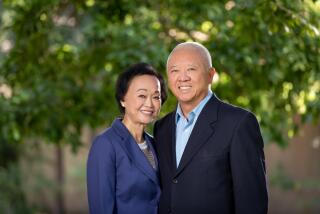A Growing Tribe of ‘Survivors’
- Share via
Mushtaque Jivani wore the number 25 with pride.
“Twenty-five? Is that what I see?” Frank McGowan, a cancer survivor from Mississippi, shouted when he saw the button on Jivani’s jacket, which represented the years he had survived since he had leukemia. “I’ve got one. We’re on our way!”
Jivani, 52, was the first patient to successfully receive a bone marrow transplant at the City of Hope Cancer Center in Duarte. On Friday, he joined nearly other 3,000 former patients, family members and doctors to celebrate the 25th anniversary of the hospital’s bone marrow transplant program.
“Today, I’ve met so many people,” said Jivani, of Long Beach. “People come to me and say, ‘You inspire me.’ That really makes my day.”
Since Jivani’s transplant in 1976, more than 4,500 similar procedures have been performed at the City of Hope.
The reunion was a celebration of life, said Dr. Stephen J. Forman, director of the division of hematology and bone marrow transplants.
“We’ve been doing this for 25 years, and it never gets old,” he said. “We think of this as a family.”
Sonja Telias, 61, of West Los Angeles, who survived the Holocaust and two episodes of cancer, wept as she looked at the many people who turned out for Friday’s event.
“It’s very emotional for me,” she said. “I thought my life was going to be over and Dr. Forman saved me. They are tears of happiness, really.”
Telias, who spent two years of her childhood hiding from the Nazis, often in a hole in a wall, was diagnosed with cancer in 1986 and again 10 years later. The second time, she underwent a bone marrow transplant.
“I’ve truly been tested,” Telias said. “I feel very fortunate. I think I’m a true survivor. I just keep coming back.”
City of Hope was one of the first six medical centers in the nation to begin treating patients with bone marrow transplants 25 years ago. The procedure involves high doses of chemotherapy or radiation therapy to kill cancer cells. Because the treatments also kill bone marrow, the patient’s immune system is revived with a bone marrow transplant.
Often, patients’ family members serve as bone marrow donors. But matches also are found through the National Donor Program, which has a database of more than 4 million potential donors.
There is always a need for more donors, said Tracy Schwartz of Long Island, N.Y. Schwartz, who lost her father to cancer, became a donor in 1998.
On Friday, she met the woman whose life she saved, 38-year-old Becky Campos of Venice. Campos was diagnosed with leukemia in 1999.
“Doctors told me it’s like finding a needle in a haystack, to find one person who is such a perfect match like Becky and I were,” Schwartz said. “It’s so important for more people to do this.”
The two women, who had been e-mailing and talking on the phone for several months, cried when they met Friday.
“How do you thank someone for your life?” Campos said. “It’s the ultimate gift. She didn’t even know me and here she went through this process to save my life.”
Two-year-old Jack LoCicero, who was diagnosed with a genetic disorder called Hurler’s syndrome, also met his bone marrow donor Friday. Doctors told his parents, Jessica and Brendan of Westminster, that if the disease were left untreated he would suffer retardation and probably die by the age of 10.
Luckily, Brad Benjamin, 29, of New Hampshire, who had registered as a donor eight years ago, was a perfect match for Jack.
Benjamin cried when he met the young boy and handed him a white teddy bear.
“This is by far the most special thing I’ve ever been a part of,” he said. “A few days out of my life is nothing, because now Jack has his whole life.”
More to Read
Sign up for Essential California
The most important California stories and recommendations in your inbox every morning.
You may occasionally receive promotional content from the Los Angeles Times.













